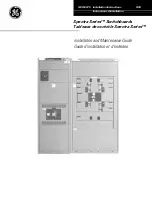
Effective 8/13/99
Page 23
I.L. 70C1037H02
Figure 5.2 Connection Details for Conducting Single
Phase Current Tests with the Breaker
Removed from the Cell
CAUTION
RESTORE ALL TEMPORARY CONNECTIONS MADE
FOR THE PURPOSE OF CONDUCTING TESTS TO
PROPER OPERATING CONDITIONS BEFORE RE-
TURNING THE BREAKER TO SERVICE.
Record the test results on the test form provided with the
equipment (Figure 8.3).
6.0 BATTERY
6.1 General
The battery plays no part in the protection function of the
trip unit.
As indicated in Figure 3.1, the battery is provided to
maintain the red LED indication of the Cause of Trip in the
Digitrip 520 family of trip units. The battery is located
under the rating plug door. A battery check pushbutton
and a green Battery Check LED are also provided in the
520 family of trip units.
6.2 Battery Check
The battery is a long-life, lithium, camera-type unit. Check
the status of the battery at any time by pressing the
Battery Check pushbutton and observing the green LED.
If the Battery Check LED does not light green, replace the
battery. The condition of the battery has no effect on the
protection function of the trip unit. Even with the battery
removed, the unit will still trip the breaker in accordance
with its settings. However, without the battery, the Cause
of Trip LED will not be lighted red. If the battery is re-
placed, one or more of the Cause of Trip LEDs may be
illuminated. Push the red Reset/Battery Test button to turn
off the indicators; the trip unit will be ready to indicate the
next cause of trip.
WARNING
PERSONAL INJURY CAN OCCUR WHEN WORKING
ON POWER SYSTEMS. ALWAYS TURN OFF POWER
SUPPLYING BREAKER BEFORE CONDUCTING
TESTS. TEST OUT OF THE CELL, IF POSSIBLE.
THERE IS A HAZARD OF ELECTRICAL SHOCK OR
BURN WHENEVER WORKING IN OR AROUND ELEC-
TRICAL EQUIPMENT.
Verify the grounding points of the system using high-
voltage testers and resistance bridges to ensure that
ground paths do not exist that could bypass the sensors.
Use a low-voltage (0 to 24 volt), high-current, ac source to
apply a test current of 125 percent of the Digitrip unit pick-
up setting through one phase of the circuit breaker. This
should cause the breaker to trip in less than 1 second and
operate the alarm indicator, if one is supplied. Reset the
breaker and the alarm indicator. Repeat the test on the
other two phases (see Figure 5.1).
Apply the same current as described above through one
phase of the breaker, returning through the neutral
sensor. The breaker should not trip, and the alarm
indicator, if one is supplied, should not operate. Repeat
the test on the other two phases.
Figure 5.1 Connection Details for Conducting Single Pole,
Single Phase Current Tests with the Breaker
Removed from the Cell
Apply the same current as described above through any
two phases of the breaker. The breaker should not trip,
and the alarm indicator,
if one is supplied, should not
operate. Repeat the test using the other two combinations
of breaker phases (see Figure 5.2).














































